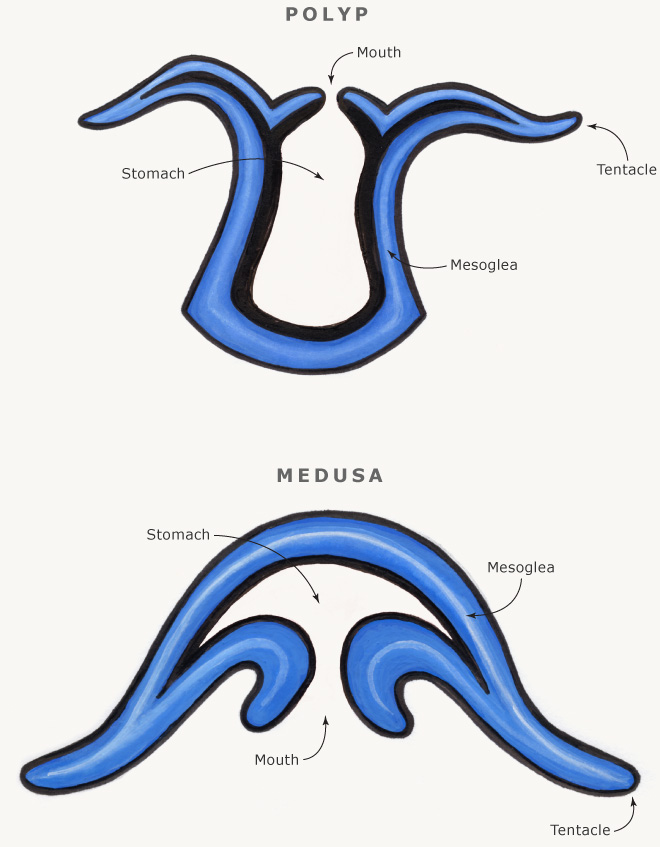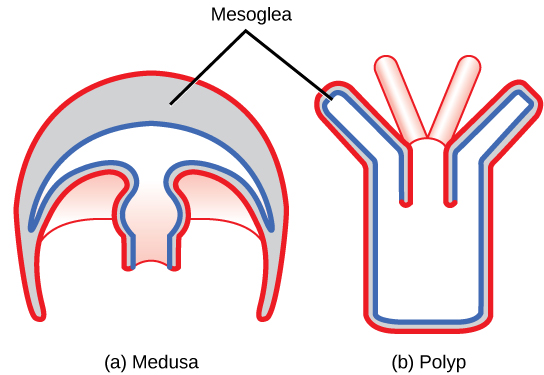List and Explain the Two Different Body Plans of Cnidarians
The Hydrozoa are colony - forming species including the freshwater hydra. 4ouH hs befujeeo fe-nf-oes -fhr khs mACyy fix cynS dcuih.
Jellyfish And Other Cnidarians
The Phylum Cnidaria Coelenterata contains about 9000 species of hydras jellyfishes sea anemones corals etc.

. Medusoid types are those like jellyfishthe body or bell is on top and tentacles and mouth hang down. Perhaps the best-known medusoid animals are the jellies jellyfish. Polyp or stalk and medusa or bell.
Cnidarians Medusa Cylindrical body arm-like tentacles mouth opens upward usually sessile Polyp Medusa bell shaped bottom mouth is at the bottom free-swimming structure fringe of tentacles that hang from the edge of the bell mouth opening located under the bell a gastrovascular. The epidermis and the gastrodermis. Parazoa Eumetazoa diploblastic or Eumetazoa triploblastic 3 Body cavity if triploblastic.
Medusa - bell-shaped and free swimming. Asymmetrical Radial or Bilateral 2 Tissue type. There is the Medusa which is a Jellyfish really.
The phylum Cnidaria is made up of four classes. Sea anemones sea pens and corals. Acoelomate Psuedocoelomate or Coelomate 4 Developmental mode if Coelomate.
These animals are attached to a substrate or colony of other animals. One of the important characteristic of them is the alteration of generations with two body forms and those are the sexual body plan medusa and the asexual body plan polyp. Examples of the polyp form are freshwater species of the genus Hydra.
All cnidarians have two membrane layers in the body. Polypoid cnidarians have tentacles and a mouth that face up think of an anemone or coral. It is important to notice that their digestive system is incomplete.
And there is a Polyp which is like an upside-down Jellyfish if you want it simply. Two lesser-known groups are tiny moss-like creatures called hydroids and the ocean-going siphonophores. Cnidarians are large and beautiful water organisms.
Describe two methods of sponge reproduction. An example of these is the hydra. Siphonophores are colonies of highly specialised individuals.
A frontal plane also called a coronal plane separates the front from the back. Which animal probably swims. Corals are cnidarians that build reefs.
Some species exhibit both body plans in their lifecycle. Polyp forms are sessile as adults with a single opening the mouthanus to the digestive cavity facing up with. In the diagram identify the two different body plans of cnidarians.
Most of them live in marine ecosystems and. 2 Tissues The two body forms of cnidariansmedusa and polypconsist of the same body parts arranged differently. Up to 24 cash back Cnidarians.
There are two types of cnidarians called polypoid and medusoid. They have a biphasic life cycle meaning they alternate between two body forms throughout their life cycle. Depending on the body plan features 3 4 may not apply to specific phyla.
Between both layers they have the mesoglea which is a connective layer. The Hydrozoa the Scyphozoa and the Anthozoa. The key characteristic features of cnidarians include radial symmetry acoelomate body with tissues lack of organs and the simple digestive sac that opens through a mouth which is surrounded by tentacles armed with nematocysts.
Protostome or Dueuterostome Note. Cnidarians may go through stages in their life cycle in which they experience each of these body plans. Cnidarian also called coelenterate any member of the phylum Cnidaria Coelenterata a group made up of more than 9000 living species.
The tissues however are not organized into organs. There are three major classes of Cnidarians. Overall though they have two main body plans.
How do cnidarians. However the overall body plan of all the cnidarians is always radially symmetrical. Where is the mouth on each.
- bu 5roel - rlesed. Name and describe one body form of cnidarians. Name and describe the other body form of cnidarians.
A midsagittal plane divides the body exactly in the middle making two equal right and left halves. Jellyfish coral hydra sea anemones. All cnidarians are carnivores and have very simple body structures adapted as predators.
Jellyfish coral sea anemones hydra The Phylum Cnidaria Coelenterata contains about 9000 species of hydras jellyfishes sea anemones corals etc. Poylp - shaped like a vase and are sessile. Their cells are organized into distinct tissues and their nervous system controls all activities of the organism.
The cnidarian body plan is more complex than that of a spongeit contains specialized tissues that carry out particular functions. Cnidarians display two distinct body plans. Cnidarians come in various body shapes and have different ways of living.
Mostly marine animals the cnidarians include the corals hydras jellyfish Portuguese men-of-war sea anemones sea pens sea whips and sea fans. Figure 6 Cnidarian body forms Mouth Medusa Polyp Mouth. The polyp or tuliplike stalk form and the medusa or bell form.
Cnidarians have two distinct morphological body plans known as polyp which are sessile as adults and medusa which are mobile. There are two types or body plans of cnidarians. Cnidarians are large and beautiful water organisms.
Polyps are sessile as adults with a single opening to the digestive system the mouth facing up with tentacles surrounding it. Corals sea anemones and jellyfish are the most familiar of the cnidarians. Two distinct body plans are found in Cnidarians.
The jellyfish body plan is like an anemone that has been turned upside down and a diverse group of cnidarians thrives at all depths of the ocean. Example - jellyfish float amond ocean currents. Polypoid in which the mouth faces up eg anemones and medusoid in which the mouth faces down eg jellyfish.
Examples are sea anemones corals and hydras. A transverse plane or horizontal plane divides the animal into upper and lower portions. Describe the body structure of cnidarians.
An example of the polyp form is found in the genus Hydra whereas the most typical form of medusa is found in the group called the sea jellies jellyfish. One anemone Stomphia can swim away from predators by contracting its entire body.

Polyp And Medusa Body Shapes Corals Anemones And Jellyfish Te Ara Encyclopedia Of New Zealand

Comments
Post a Comment